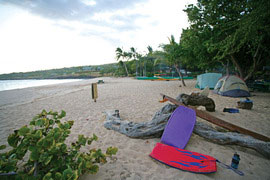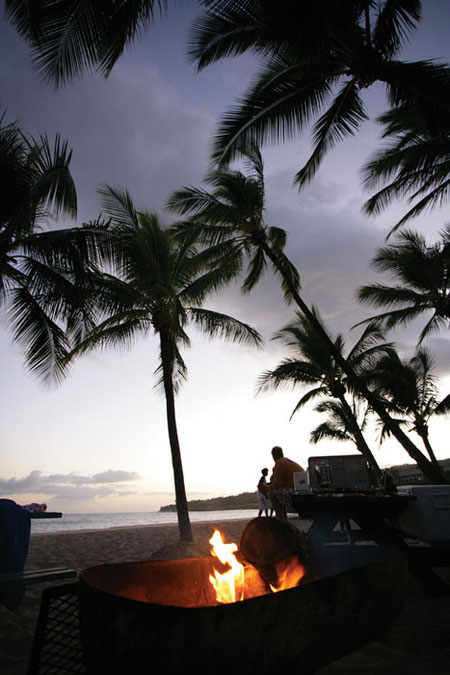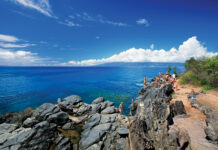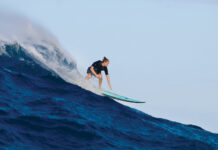Jason Hilford | Photography by Jason Moore
 The Lana‘i ferry dodges a moored sailboat and backs into Lahaina Harbor off a spectacular three-point turn. It’s Wednesday afternoon, and my wife and I are on the cusp of a much-deserved overnighter at Hulopo‘e Beach, the site of the “Secluded Isle’s” sole official campground. Even those of us lucky enough to live and work on Maui need an escape, albeit a short one.
The Lana‘i ferry dodges a moored sailboat and backs into Lahaina Harbor off a spectacular three-point turn. It’s Wednesday afternoon, and my wife and I are on the cusp of a much-deserved overnighter at Hulopo‘e Beach, the site of the “Secluded Isle’s” sole official campground. Even those of us lucky enough to live and work on Maui need an escape, albeit a short one.
Amid a sea of golfers and tourists subtly shoving each other aside for that coveted deck seat, we make our way onto the ferry. The few Lanaians hang in the shade with their loads of Costco purchases. (No big-box stores on Lana‘i!) We’re out of the harbor before we know it, gliding past the surfers catching the south swell at Breakwall. There’s something about a ferry ride that evokes in me a sense of adventure—even if the port is only an hour from my house. Lahaina Town suddenly looks tiny from half a mile out, climbing the hill and giving way to a striking view of the West Maui Mountains and, eventually, Haleakala in the distance.
 Although a camping trip to Hulopo‘e is hardly a lesson in adversity (stores and restaurants are just a quick shuttle ride away), it’s a far cry from the luxury available on Maui—or for that matter, up the hill at Lana‘i’s equally fancy resorts. We’re carrying all of our food in a cooler, and our bed in a backpack; this isn’t a trip for those expecting creature comforts beyond an easy evening breeze and—an especially lavish addition to any campground—a clean bathroom. Rather, we’re after the pure experience of waking up under a palm tree to the sound of breaking waves.
Although a camping trip to Hulopo‘e is hardly a lesson in adversity (stores and restaurants are just a quick shuttle ride away), it’s a far cry from the luxury available on Maui—or for that matter, up the hill at Lana‘i’s equally fancy resorts. We’re carrying all of our food in a cooler, and our bed in a backpack; this isn’t a trip for those expecting creature comforts beyond an easy evening breeze and—an especially lavish addition to any campground—a clean bathroom. Rather, we’re after the pure experience of waking up under a palm tree to the sound of breaking waves.
As we round Lana‘i’s southeast corner, the island’s profile reflects the exact picturesque austerity we crave in all our travels. Essentially a plateau, Lana‘i rises dramatically from the ocean on all sides, but especially here on the south coast, where wave-carved cliffs rise hundreds of feet over our heads, and the rocky coastline belies any possibility of a safe landing.
That place does exist, though, in tiny Manele Small Boat Harbor—a placid port for a handful of boats. Picnic tables, trees, and a small restaurant make Manele one of the most pleasant harbors I’ve had the pleasure of passing through. We debark and start the short final leg of our journey, camping supplies in tow. I’m of the staunch belief that a night camping can only be enhanced when you have to work a little for it—and although it’s a fact we seem to have forgotten in our car-obsessed society, a ten-minute walk isn’t really that much work for an able-bodied person. Hiking the shoulderless road with our backpacks, shopping bags, and cooler-on-wheels, we giggle at our probable resemblance to a pedestrian Joad family in search of greener pastures.
Ten minutes later, greener pastures we find. As the huge lawn ahead opens up to a tree-lined coastline, we know we’re home . . . for the night. Hulopo‘e approaches the Platonic ideal Hawaiian beach, with the prerequisite clear blue water and the short grass, palm trees, and native naupaka fringing the sand.
The campground itself is, like most things on Lana‘i, only as big as it needs to be: a rectangle of ground divided into six sites. Within 15 minutes, after the usual squabble about where to put the tent, and a quick hunt for rocks to pound the tent stakes, we’re pau with our day’s labor and ready to engage in the serious and efficient dawdling that seems to mark all of our trips.
Nothing encourages lollygagging more than a beach, and we’re within easy striking distance. The sand is lined with tents, undoubtedly local property; Lana‘i residents have the exclusive right to obtain permits for camping literally on the beach. And though I’m a little jealous—I’ve slept on plenty of beaches (sometimes by choice), and dry sand is far more comfortable than any blow-up mattress—I concede their claim. It’s 3 p.m., and the barbecues are already fired up. Children laugh and play in the surf. Families spanning three, four generations gather in the shade around the plentiful picnic tables filled with food. In true idyllic kama‘aina fashion, Lana‘i is at the beach in full force.
One standard Hawaiian sight is not part of the scene, though: no fishing poles on the beach, and nobody is wading into or emerging from the water with a spear. As we enter the shore break, I remember that Hulopo‘e is part of a marine sanctuary, so the fish can relax as readily as can the people. Armed with masks and snorkels, we time the formidable shore break just right and swim out into significantly calmer waters. The lava outcroppings surrounding the bay fend off the currents whipping by offshore of Lana‘i toward Micronesia, making Hulopo‘e a perfect (and safe) beach for swimming and snorkeling.
After years of protection, the fish seem to know they’re not in danger of becoming poke, so they laze and graze around the towering coral heads, unconcerned with the funny-looking bipeds ogling them through plexiglass. Afternoon is not generally peak snorkeling time, but the water is amazingly clear, and we’re content to look around for a while. I’m no fish expert, but I come across enough species to stay entertained for an hour—for me, practically a snorkeling marathon. Finally tired of clearing my mask, I pull it off and float on my back. Could there be any better way to spend a Wednesday afternoon?
From out in the water, the rest of the bay really opens up to my view. Manele Bay Resort, an island in itself amid its golf courses, dominates the shoreline just to the west. I have nothing against people who enjoy staying in opulent hotels, but as someone who strongly favors a plot of dirt and a firepit to fresh linens and room service, I direct my vision in the opposite direction, where a hiking trail scales the rugged headland that rises above Hulopo‘e’s renowned tide pools, forming the bay’s eastern limit. The trail continues upward to the top of some dizzyingly high cliffs. Like most of the island, the landscape there is rocky, reddish, and barren—and above all, strikingly beautiful.
This is the essence of Lana‘i: a quiet, rugged place whose magnificence lies, paradoxically, in its utter simplicity. Satisfied, we drift back toward the beach and, equally important, the outdoor shower. The mostly local crowd on the beach is already settling in for the evening—the barbecue smoke is thick and enticing. But we, too, have planned well; back at the campsite, I dig through the cooler for our precooked dinner—barbecuing is always fun, but when you’re on foot, briquettes become just another load to schlep.
As the full moon emerges, we sip our chilled gin-and-juice mix in the light breeze, listening to the guitar and ‘uke music floating up from the beach. We stretch out on the picnic table that is ours for the night, and watch the stars. We’ve finally reached that point of tranquility and total sensory awareness that only camping can provide. At this point, sleep is entirely incidental.
Tomorrow, we’ll wake up in our tent under the prescribed palm tree (technically, it’s a kiawe and not a palm, but I’m past caring) and return, refreshed, to the Valley Isle’s version of professional life. Camping at Hulopo‘e is like pressing a “reset” button; the sticky and strangely fragrant layer of campground grime covering our bodies will remind us that a clean slate is just a quick boat ride away.
For camping prices and reservations, call (808) 565-2970. For ferry times and prices, call Expeditions at (800) 695-2624 or visit www.golanai.com.





